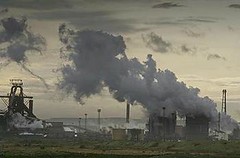一群科學家警告,人口成長、大範圍的破壞自然生態系以及氣候變遷等因素,讓地球的生物圈朝向不可逆轉的改變,使地球被逼到極限而導致毀滅性的後果。
這份報告以過去全球變遷造成的生物性影響與現在的狀況相比,並以證據評估了將來的可能性。6月7日出版的《自然》期刊登出了這篇文章,本期的焦點聚集在環境問題上,而聯合國永續發展大會(Rio+20)將於6月13至22日於巴西的里約熱內盧舉行。
報告的第一作者,加州大學柏克萊分校綜合生物學教授AnthonyBarnosky表示,「到那個時候,在生物學上會是一個全新的世界。」
研究的資料顯示,生物多樣性將會下降,並且我們賴以生存的漁業、農業、林業與乾淨的水源都將受到嚴重的影響。」Barnosky說道,「這將會在幾個世代之內發生。」
 Barnosky說,「這樣生物圈的重大變化結果將會是混合性的」,「一部分的植物與動物會消失,剩下的物種組成新的組合,而農作物生長的地點將會受到重大的影響。」
Barnosky說,「這樣生物圈的重大變化結果將會是混合性的」,「一部分的植物與動物會消失,剩下的物種組成新的組合,而農作物生長的地點將會受到重大的影響。」
研究的共同作者,史丹佛大學的ElizabethHadly說,「對世上一些地區來說,我們可能已經超過了這些臨界點,我剛從尼泊爾的喜馬拉雅山回來,在那裡目睹鄰舍間為了煮飯的柴火大打出手,這些柴火也不過只能煮一餐。」
「在缺乏政府基礎建設的地區,人們只能自生自滅,生物多樣性也受害。」Hadly說道,「我們的地球亟需要整體性的領導。」
研究報告作者指出,小規模的生態系研究顯示,一旦50%至90%的地區被改變,整個生態系就會進入一個無法挽回的臨界點,動植物物種以及其交互關係會變成完全不同的樣貌。這樣的情況通常源自物種滅絕以及生物多樣性下降。
目前來說,為了支持70億人口,大約有43%的地表被轉化以進行農業使用,剩下的地方也被道路切割穿越。
全球人口預計在2045年達到90億,依照上述的人口成長率,在2025年時將有50%的地表土地被人類利用。
對Barnosky來說,這已接近令人不安的地球臨界點。
「這真的會發生嗎?檢視過去的歷史所得到的答案是肯定的,這是曾經發生過的。上一次發生在11700年前的冰河期/間冰期是個例子,」他說道,並指出生物多樣性仍然沒有從那次的滅絕中完全恢復。
Barnosky說,「我認為如果我們要避免最糟的情況,我們就應該遠離這個50%的臨界點。」
柏克萊全球變遷生物學計畫(BiGCB)是一個動員來自各個優異學門,超過100名柏克萊大學科學家參與的大型計畫,並接受高登與貝蒂摩爾基金會(GordonandBettyMooreFoundation)250萬美金以及凱克基金會(KeckFoundation)150萬美金的資助。
這份由Barnosky與其他人合著的報告於2010年由BiGCB在加州柏克萊大學首次舉辦的研討會中發表,討論全球臨界點的概念,並商討如何識別與避免它。
 該次會議中,22名與會者整合了可取得的過去全球變遷資料、現今全球環境所受威脅以及通過臨界點之後會發生的事。
該次會議中,22名與會者整合了可取得的過去全球變遷資料、現今全球環境所受威脅以及通過臨界點之後會發生的事。
他們作出的結論是,極需要全球合作來減少人口成長率以及人均資源使用量,並以永續性的能源取代化石燃料,發展更有效的糧食生產方式與產地而不使用更多土地,並且以更好的方式管理尚未被人類侵佔的土地,以作為生物多樣性的保留地與生態系統服務。
Population growth, widespread destruction of natural ecosystems, and climate change may be driving Earth toward an irreversible change in the biosphere, a planet-wide tipping point that would have destructive consequences, warns a group of scientists from around the world.
The paper compares the biological impact of past incidences of global change with processes under way today and assess evidence for what the future holds. It appears in the June 7 issue of the journal "Nature," which is focused on the environment in advance of the June 13-22 United Nations Rio+20 Earth Summit in Rio de Janeiro, Brazil.
"It really will be a new world, biologically, at that point," warns Anthony Barnosky, professor of integrative biology at the University of California, Berkeley, and lead author of the paper.
"The data suggests that there will be a reduction in biodiversity and severe impacts on much of what we depend on to sustain our quality of life, including, for example, fisheries, agriculture, forest products and clean water," said Barnosky. "This could happen within just a few generations."
The result of such a major shift in the biosphere would be mixed, Barnosky said, with some plant and animal species disappearing, new mixes of remaining species, and major disruptions in terms of which agricultural crops can grow where.
Coauthor Elizabeth Hadly from Stanford University said, "We may already be past these tipping points in particular regions of the world. I just returned from a trip to the high Himalayas in Nepal, where I witnessed families fighting each other with machetes for wood - wood that they would burn to cook their food in one evening."
"In places where governments are lacking basic infrastructure, people fend for themselves, and biodiversity suffers," Hadly said. "We desperately need global leadership for planet Earth."
The authors note that studies of small-scale ecosystems show that once 50 to 90 percent of an area has been altered, the entire ecosystem tips irreversibly into a state far different from the original, in terms of the mix of plant and animal species and their interactions. This situation typically is accompanied by species extinctions and a loss of biodiversity.
Currently, to support a population of seven billion people, about 43 percent of Earth's land surface has been converted to agricultural or urban use, with roads cutting through much of the remainder.
The global population is expected to rise to nine billion by 2045; at that rate of population growth, current trends suggest that half of the Earth's land surface will be disturbed by 2025.
To Barnosky, this is disturbingly close to a global tipping point.
"Can it really happen? Looking into the past tells us unequivocally that, yes, it can really happen. It has happened. The last glacial/interglacial transition 11,700 years ago was an example of that," he said, noting that animal diversity still has not recovered from extinctions during that time.
"I think that if we want to avoid the most unpleasant surprises, we want to stay away from that 50 percent mark," Barnosky said.
Research to develop the reliable, detailed biological forecasts the paper is calling for is now underway at UC Berkeley.
The Berkeley Initiative in Global Change Biology, or BiGCB, is a massive undertaking involving more than 100 UC Berkeley scientists from an extraordinary range of disciplines that already has received funding in the form of a $2.5 million grant from the Gordon and Betty Moore Foundation and a $1.5 million grant from the Keck Foundation.
The paper by Barnosky and others emerged from the first conference convened under the BiGCB's auspices held at UC Berkeley in 2010 to discuss the idea of a global tipping point, and how to recognize and avoid it.
Following that meeting, 22 of the attendees summarized available evidence of past global state-shifts, the current state of threats to the global environment, and what happened after past tipping points.
They concluded that there is an urgent need for global cooperation to reduce world population growth and per-capita resource use, replace fossil fuels with sustainable sources, develop more efficient food production and distribution without taking over more land, and better manage the land and ocean areas not already dominated by humans as reservoirs of biodiversity and ecosystem services.
全文及圖片詳見:ENS報導




